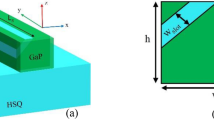Abstract
A new wavelength-tunable polarization converter utilizing the strain induced by proton exchange is demonstrated in x-cut LiNbO3. The light polarization is converted by the strain-optic effect through the phase-matched coupling of two orthogonal polarizations. The stress-applying structure is designed to be composed of several proton-exchanged strip regions for maximization of the stress distribution. The principle of birefringent chain filters is utilized to design the device structure in order to avoid the requirement of large stress, which results in serious cracks on the substrate surface. The overlap integral between the optical field distribution and the stress distribution can be enhanced simply by prolonging the proton-exchange time. Besides, the stress distribution and its strength in the stress-applying structure can be fine tuned without affecting the waveguide characteristics such that the principle of the birefringent chain filters is completely satisfied. Therefore, the polarization-conversion efficiency can be optimized when utilizing this exclusive stress-tuning ability. By the thermal-optic effect, the wavelength of maximum conversion can be tuned at a rate of -0.115 nm/°C with a maximum conversion efficiency of 92.41%. The proposed polarization converter has the advantages of adequate stress distribution and strength, high parameter-tuning feasibility, low propagation loss, easy fabrication, and low fabrication cost.
Similar content being viewed by others
References
H. Porte, J.P. Goedgebuer, R. Ferriere, N. Fort: IEEE J. Quantum Electron. QE-25, 1760 (1989)
L.N. Binh, J. Livingstone, D.H. Steven: Opt. Lett. 5, 83 (1980)
P.K. Tien, R.J. Martin, R. Wolfe, R.C. Le Craw, S.L. Blank: Appl. Phys. Lett. 21, 394 (1972)
Z. Tang, O. Eknoyan, H.F. Taylor, V.P. Swenson: Appl. Phys. Lett. 62, 1059 (1993)
T. Lang, F. Bahnmüller, P. Benech: IEEE Photon. Technol. Lett. 10, 1295 (1998)
H.S. Jung, O. Eknoyan, H.F. Taylor: Jpn. J. Appl. Phys. 38, L1406 (1999)
K. Merterns, B. Scholl, H.J. Scymitt: IEEE Photon. Technol. Lett. 10, 1133 (1998)
J.Z. Huang, R. Scarmozzino, G. Nagy, M.J. Steel, R.M. Osgood, Jr.: IEEE Photon. Technol. Lett. 12, 317 (2000)
I. Šolv: J. Opt. Soc. Am. 55, 621 (1965)
C.E. Rice: J. Solid State Chem. 64, 188 (1986)
M. Minakata, K. Kumagai, S. Kawakami: Appl. Phys. Lett. 49, 992 (1986)
F. Zhou, A.M. Matteo, R.M. De La Rue, C.N. Ironside: Electron. Lett. 28, 87 (1992)
Author information
Authors and Affiliations
Corresponding author
Additional information
PACS
42.82.-m
Rights and permissions
About this article
Cite this article
Wang, TJ., Chung, JS. Wavelength-tunable polarization converter utilizing the strain induced by proton exchange in lithium niobate. Appl. Phys. B 80, 193–198 (2005). https://doi.org/10.1007/s00340-004-1702-4
Received:
Published:
Issue Date:
DOI: https://doi.org/10.1007/s00340-004-1702-4




